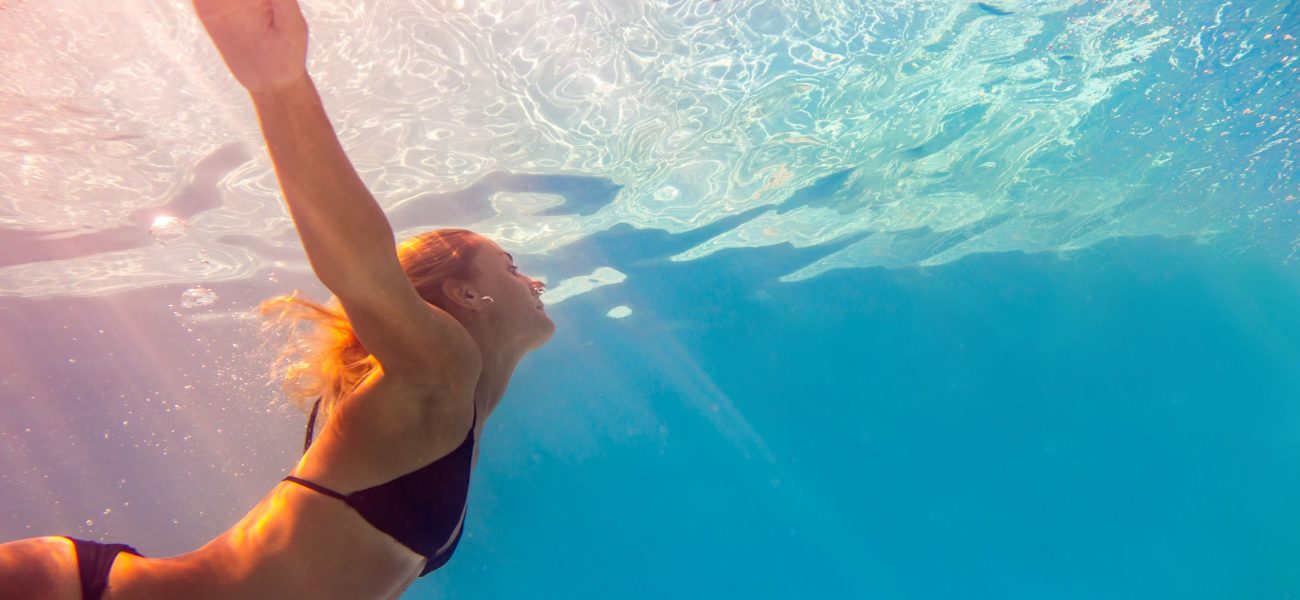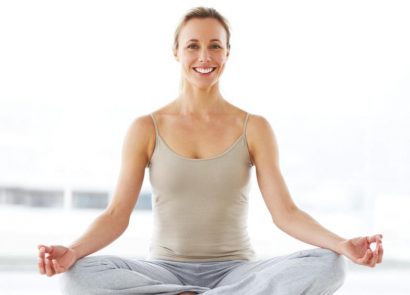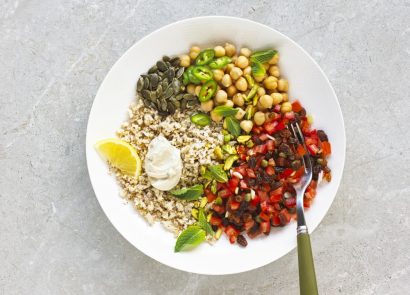There’s nothing like diving into a body of cool open water on a hot summer’s day or taking an invigorating dip at your local swimming pool to burn off some stress. Not only that, but if you want to change your age at a cellular level, cardio is king. According to a study in the European Heart Journal, endurance exercises such as running, swimming and cycling are the best at slowing down the signs of ageing.
“Anti-ageing is about more than heaping on the creams, it’s about actively trying to lower your biological age,” says Keith McNiven, founder of London based personal training company Right Path Fitness. “It’s a combination of both your genes and how well you’ve looked after your body – and a huge indicator is heart health. If your biological age exceeds your actual age, you can have prematurely hardening arteries and thickening walls.”
Look after your heart by doing anything that gets your heart rate up. With regular cardio like swimming three to four times a week, you’ll lower your maximum heart rate and keep it as young as it can be. Follow an easy swimming workout with this guide, incorporating backstroke, front crawl, breaststroke and butterfly. There are huge benefits to cold water swimming, too. Here are just some of the ways you can experience swimming, with some tips from some of the biggest celebrity swimmers.
Wild swimming
Known for its naturalistic and holistic benefits, wild swimming is excellent for those looking to try out something new this summer, and it’s a sure-fire way to boost your vitality. “Open water swimming is about efficiency,” says Peigh Asante, part of the Swim Dem Crew who recently hosted an open water masterclass with Nike Swim. “It’s not about going as fast as you can in the open water, it’s about swimming effectively, so you can travel the maximum distance with minimal effort. This means incorporating an effective glide in the water after each arm pull, and kicking legs for body balance first, rather than propulsion.” Fancy giving it a go? Visit outdoorswimmingsociety.com to find out where you can swim in the UK and abroad.

Swimming in the sea
“Waves, wind and the unevenness of swells and tides create a unique muscle experience when open water swimming in the sea,” says fitness expert Greg Sellar. “Your swimming stroke and pace will be greatly disrupted and this leads to a quicker fatigue time than swimming in a pool. Unless the water is crystal clear, you will have to lift your head to see where you are going, and it’s advisable to wear goggles. You should be able to swim five to seven strokes before lifting your head without seriously straying off course, but be mindful of your breathing. Swimming along the shoreline is recommended to begin with, and it’s a good idea to also let a lifeguard know your plans so they can keep an eye on you.”

What the celeb swimmers say
Kirsty Gallagher
Fresh from a holiday in Sardinia with her family and buzzing with energy after a swim workout, Kirsty Gallagher barely stops to take a breath when we catch up with her on a sunny day in August to talk about her love of swimming and being in the pool.
The 40-year-old Sky Sports presenter and former Strictly Come Dancing contestant has long been known for her toned physique and she takes her health and fitness seriously, but swimming in particular has always been a passion for her.
“Exercise for me is really vital,” she explains. “Not only do I like to feel strong and look toned, but fitness is good for my mind and it makes me feel great. Plus, I’m very energetic and need to put that energy somewhere,” she laughs.
Alongside her presenting work, Kirsty has been an ambassador for Speedo. In 2016, she travelled around the country promoting the swimwear brand’s Dive In campaign, which aimed to get adults into the water and get swimming. With 10,000 free swimming sessions being offered at local leisure centres nationwide, it was a huge drive and it’s clearly an area that the mum-of-two is very passionate about.
On the benefits of swimming
“I’ve always been into swimming and used to swim a lot when I was younger,” she explains. “When I was growing up I was lucky enough to have a pool at home and I was a bit of a water baby – in fact all of us Gallacher kids were. I really enjoyed it and did butterfly and front crawl at school too. Both of my sons are strong swimmers and I think it’s really important to teach children how to be safe in the water from a young age.”
Nowadays, she swims twice a week and uses it to complement her weight training and sessions with her personal trainer.
“The swimming that I’ve been doing has been brilliant and it’s worked really well alongside my other training. Since I’ve been in the water more, I’ve noticed that my muscles have been toning up quicker while I’ve been doing my weights training, and I’ve definitely improved my cardio fitness too.
“What I love about swimming is that it can offer you whatever you want,” she adds. “You can use it as a cardio session to get your heart rate up by doing lengths and really just going for it, or you can go in the pool for a relaxed stretching session. You can use the water to sort your body out and it just feels like rehab. I have a bit of an arm injury – I had a bad bout of tennis elbow which came from my gym work a few years ago – and sometimes it rears its ugly head. On these occasions, I get in the pool and work on my arms. Stretching them out in the water feels really nice.”
How to get more confident when swimming
Kirsty’s advice for people who are hesitant about getting into the pool is to start slowly. “Begin by doing 20 lengths and then slowly up it until you’re doing 50,” she advises. “You can do it at any speed, using whatever stroke you like and you’ll soon see improvements.”
And, most importantly of all – let any anxiety go. “A lot of people are very body-conscious and if they haven’t swum for years it can feel quite scary getting into a swimming costume or bikini and getting in the water. I do understand that,” she says. “But once you get past that and find a nice local pool, it’s about letting go of your inhibitions and just diving in. Everyone’s in the same boat, if you don’t mind the pun. Everyone has the same concerns and fears and no-one will be looking at you – they’re all concentrating on their own worries and their own goals. Once you’ve done it the first time it will get easier, and you’ll soon realise just how beneficial swimming can be.”
Tom Daley
Being Britain’s youngest ever European gold medalist diver and a two-time bronze Olympic medalist, it’s fair to say that Tom Daley knows a thing or two about focus, determination and health. I mean, he didn’t get those abs and 51 (yes, 51!) medals overnight. So when his first book, Tom’s Daily Plan landed on our desk, we took note. These three life hacks are just what we need to help us achieve pool-readiness.
Morning life hack: Meditation
“You might think meditation is not for you. I wasn’t too sure at first, but I started meditating in 2013 and now I’m hooked,” explains Tom. “Most mornings I like to get up early enough to eat a proper breakfast and to meditate. Then I head off for training feeling calm, focused and rested. Here’s a 10-minute meditation exercise you could do at home before you start your day. It’s so worth it.”
- Find a quiet spot and sit comfortably on a chair with a straight back. Shut the door and try to make sure you’ll be left undisturbed for 10 minutes.
- Close your eyes. Take three deep breaths, inhaling through your nose and breathing out through your mouth. Focus on the physical sensations in your body. Think about how your feet feel against the floor and your back against the chair. Can you feel your abdomen rise and fall with each breath you take?
- From your head downwards, scan through your body, working down to your feet. Notice the feelings you have: which parts feel relaxed, tight or numb? Note the sensations but don’t try to change them.
- Once you’ve scanned right down to the tips of your toes, come back to focusing your mind. Notice your breath and how it feels. Count 10 breaths. If thoughts come into your mind, just bring your attention back to your breath.
- Now turn your thoughts to your body. Count to three and then gently open your eyes when you feel ready.
Lunchtime life hack: how to boost your energy
“Like lots of people I’m usually at my best in the morning, then after lunch or in the early afternoon I can start to run out of steam,” Tom admits. “I’ve learned how to give my energy levels a boost so I can keep going and make the most of my day. Here are some simple tips that have helped me, and will help boost your energy when you fancy a swim.”
-
Drink water
Water is the main source of energy in the body and I always carry a bottle of water around with me. Thirst is a sign that your energy levels are depleted, so don’t wait until you feel thirsty to grab a drink of water because by then you’ll already be dehydrated. Always choose water over fruit juices and other drinks – if you get bored, add a slice of lemon or cucumber to your water.
-
Avoid snack foods
We all know how easy it is to reach for the biscuit tin when you feel you need an energy boost, but don’t! Keep away from temptation and have some healthy snacks, such as a handful of nuts or some power balls.
-
Grab a coffee
Caffeine can be a great pick-me-up – but don’t have too much of it. Simple black coffee is low-calorie, cheap and easily available. You’ll get energy fast because there’s no milk or added fats, so your body will metabolise the coffee more quickly.





















